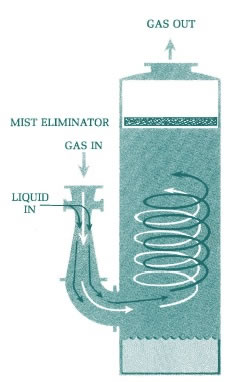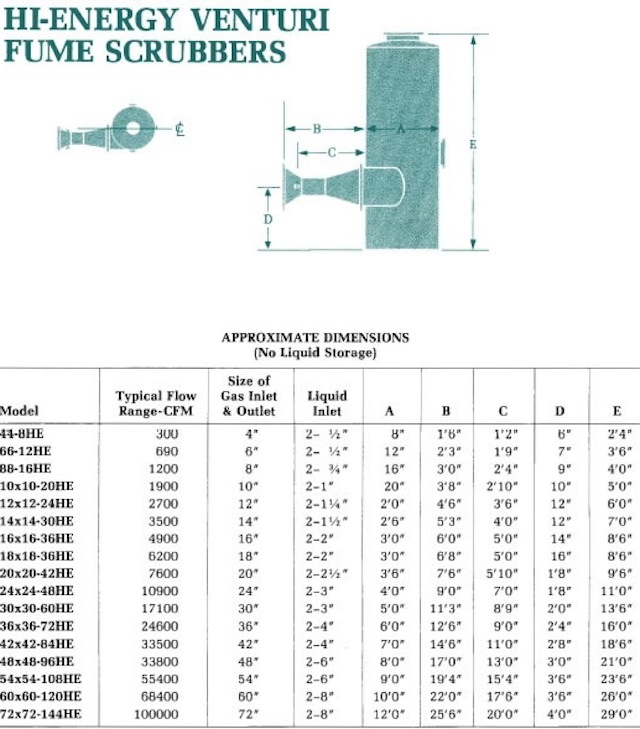 The CR Clean Air Group’s High Energy (HE) Venturi Fume Scrubbers use energy from a high velocity gas stream to atomize a liquid stream. This scrubber is particularly well suited to collecting smaller particles where standard Jet Venturi scrubbers or similar systems are ineffective for the amount of energy required. Designed without moving parts for long-term service and little or no maintenance, HE Venturi Scrubbers are available with a fixed throat design for a specific gas flow, or with a variable throat design which can be adjusted to fluctuating operating conditions.
The CR Clean Air Group’s High Energy (HE) Venturi Fume Scrubbers use energy from a high velocity gas stream to atomize a liquid stream. This scrubber is particularly well suited to collecting smaller particles where standard Jet Venturi scrubbers or similar systems are ineffective for the amount of energy required. Designed without moving parts for long-term service and little or no maintenance, HE Venturi Scrubbers are available with a fixed throat design for a specific gas flow, or with a variable throat design which can be adjusted to fluctuating operating conditions.
How High Energy Venturi Fume Scrubbers Work: In operation, the HE Venturi Scrubber uses the energy from a high velocity gas stream to atomize a liquid stream. The high atomization of the liquid and the extreme turbulence in the Venturi throat give this scrubber its exceptionally high ability to remove small micron or sub-micron dust particles. The effectiveness of this unit is dependent upon the gas velocity in the throat. It also varies with the liquid to gas ratio.
Venturi scrubbers can be one of two basic designs. They are either of simple construction, using a fixed throat which is designed for a specific gas flow; or they can have a variable throat design which can be adjusted to the operating conditions. Whenever possible, a fixed throat Venturi is preferable because of its lower first cost and reduced maintenance. A variable Venturi throat can be used with wider variations in gas rates and can be adjusted to meet exact design conditions.
Little or no maintenance is required on the Venturi scrubber. There are no internal moving parts to wear or come out of alignment. The liquid is introduced through spray nozzles that can be easily removed through the flanges provided. The use of spray nozzles allows the Venturi scrubber to be installed horizontally as well as in the conventional vertical position.
The gas from the Venturi section is normally discharged into a cyclonic separator. A spin is imparted to the gas in this cyclone separator so that the liquid is driven to the outside wall through the spinning action of the gas. The liquid is then collected and returned to the sump where it can be recycled. A final Chevron is · normally employed to assure the highest efficiency possible. This separator is particularly well suited to variable gas flows since it is effective over a wide range of operating conditions and insures against loss of liquid droplets from the separator.
Non-Clogging Spray Nozzles: The nozzles used contain no internal components and consist merely of a specially designed slot cut into a section of pipe. This creates a fan-shape distribution of the liquid just prior to the Venturi throat. As a result, high slurry contents can be handled, and abrasion problems are eliminated.
 When To Specify And When Not To Specify Variable Throat Design: Variable throats can be used if the flow continues to fluctuate widely. Very often these are not necessary. For example, the same efficiency can be obtained over a range of ± 20% from a design condition without changing the overall pressure drop or liquid rate in a Venturi scrubber. This is true because at higher liquid to gas ratios the efficiency increases for a given velocity through the throat. The slightly lower velocity through the throat is compensated by the slightly higher liquid to gas ratio so that the net effect is no difference in performance. This is particularly helpful where continuous small fluctuations of 10 or 15% will occur around some fixed design condition. It is also helpful where a unit can be designed for the lower gas flow rate, and an increase of up to 50% will still not upset the performance of the unit; it eliminates the need for purchasing an expensive actuator mechanism and reduces the overall cost of the installation.
When To Specify And When Not To Specify Variable Throat Design: Variable throats can be used if the flow continues to fluctuate widely. Very often these are not necessary. For example, the same efficiency can be obtained over a range of ± 20% from a design condition without changing the overall pressure drop or liquid rate in a Venturi scrubber. This is true because at higher liquid to gas ratios the efficiency increases for a given velocity through the throat. The slightly lower velocity through the throat is compensated by the slightly higher liquid to gas ratio so that the net effect is no difference in performance. This is particularly helpful where continuous small fluctuations of 10 or 15% will occur around some fixed design condition. It is also helpful where a unit can be designed for the lower gas flow rate, and an increase of up to 50% will still not upset the performance of the unit; it eliminates the need for purchasing an expensive actuator mechanism and reduces the overall cost of the installation.
Where higher variations and gas flow rates can be anticipated, a variable throat is essential. The Clean Air’s variable throat design involves a center cone that reduces the cross-sectional area of the throat uniformly. This is a distinct advantage since it eliminates the possibility of interfering with the liquid distribution in the gas. It helps to assure that the performance is uniform over a wide variation in gas flow rates.
In principle, an actuator senses the pressure drop across the unit and positions the spindle containing the throat reduction cone. As the gas flow rate falls off and the pressure drop tends to decrease, the spindle will position the cone further into the throat and increase the pressure drop. This helps to maintain a constant efficiency. Normally, the Venturi scrubber is supplied complete with actuator, but without any other instrumentation.
Manually Adjustable Throat: For applications where occasional adjustment is necessary, a manually adjustable throat can be used. These throats are usually designed using a damper type mechanism in the throat. The damper is usually designed to allow gas to pass freely through the Venturi under all positions. That is, to never completely close off the cross-sectional area.
The manually adjustable throat is economical and provides good performance without the need for automatic controls.
Where The Venturi Scrubbers Are Used: The Clean Air Group’s HE Venturi Scrubber is particularly well suited to smaller particle sizes and is used in the range where the standard scrubbers are no longer effective for the amount of energy required. This is principally in the less than 3 micron particles size range, and particularly for particles less than 1 micron (sub-micron). The unit can be used to obtain high efficiencies on smaller particulates.
Typically, for a 90% efficiency at any particle size, the rule-of-thumb to calculate the amount of energy required would be:
 This is based on a typical liquid-to-gas ratio of 15 gpm per thousand CFM in a standard fixed throat design. Normal pressure drops would be in the 5″ water gauge up to 60″ water gauge or more range. Ordinarily, the pressure drop would be 15″ to 40″ water gauge. The exact pressure drop has to be calculated since it varies with the particle size, grain loading, and distribution of particles.
This is based on a typical liquid-to-gas ratio of 15 gpm per thousand CFM in a standard fixed throat design. Normal pressure drops would be in the 5″ water gauge up to 60″ water gauge or more range. Ordinarily, the pressure drop would be 15″ to 40″ water gauge. The exact pressure drop has to be calculated since it varies with the particle size, grain loading, and distribution of particles.
Moderate gas absorptions can be obtained using the Venturi scrubber. Normally, efficiency such as 90% on HCL can be obtained simultaneously with particulate removal. If higher efficiencies are required, our standard Packed Tower can be combined with the Venturi scrubber to obtain the necessary removal of contaminants.
Materials Of Construction: Since all Clean Air Group’s standard HE Venturi Scrubbers are specifically designed for the individual application, materials of construction can vary over a wide range. Most commonly employed are fiberglass, steel, and stainless steel. Other special materials such as Incoloy 600, high-alloy stainless steels, and rubber-lined construction can be used where necessary.
Non-Recirculating And Recirculating Systems: Both non-recirculating and recirculating systems can be used with the Venturi scrubber. When high heat loads are present or extremely corrosive materials are handled, a non-recirculating system is often employed. Recirculation of the liquid is not a difficult problem because the nozzles are specifically designed to avoid any plugging problems. High concentrations (up to 15 to 20 wt. % solids) can be handled without difficulty. Where particularly sticky substances are handled, an extra set of wash-down spray nozzles is very often located at the inlet to the Venturi scrubber. This helps to assure that all walls continue to be thoroughly wetted and build-up of solids does not occur.
Wash Down Quench: For very high inlet temperatures, the Clean Air Group designs a complete selection of quench units using either ceramic lining or special alloys. These quench sections reduce the inlet gas temperature and volume prior to the Venturi. This reduces the size of the Venturi and also allows for the use of less expensive materials of construction for the Venturi and separator.
Occasionally high solid loadings or special handling requirements make a completely wetted wall design essential. Special wash-down systems are available from the Clean Air Group along with other modifications. Since all units are custom designed, any combination of features can be supplied in a single unit.
Larger Capacities: Sizes shown in the bulletin can be shop fabricated and shipped directly to the jobsite. For larger flow cases, field erection or multiple units would be required. The Clean Air Group can provide the necessary technology to design larger diameter units. Flows of close to 500,000 acfm have been handled in the Clean Air Group’s scrubbers in a single unit. Please contact the factory directly for further information on a specific application.
Download our corporate brochure

